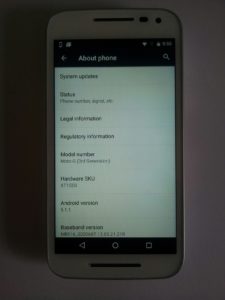| Dimensions | 142.1 x 72.4 x 11.6 mm |
| Weight | 155 g |
| Display | 5″ (720 x 1280 pixels) | 294 ppi |
| Camera | 13 megapixels (rear) | 5 megapixels (front) |
| Hardware | Qualcomm MSM8916 Snapdragon 410 |
| Battery | Non-removable Li-Ion 2470 mAh battery |
| RAM | 8GB/1GB RAM & 16GB/2GB RAM |
| Storage | 8/16 GB internal with MicroSD upto 32 GB |
| Operating System | Android 5.1.1 |
| Durability | IPX7 |
| Colors | Black,White |
Now that we have seen the critical specifications of the device, lets look at each aspect of the Moto G 3rd gen. in a bit more detail.
- Design – Nowadays, when it comes to designing a new device, you seldom find something done to the mid range or entry level devices. Its mostly the flagships that get all the attention, since people expect something new in every new flagship. Motorola however, has given a fresh overhaul to their mid ranger as well. While the Moto G 2nd gen was also quite different from the Moto G 1st, gen, it still retained the design language and feel. This time around, Motorola have changed it all. While this does sound good for someone looking for a new mid range device, its not all goody goody here either. Changing the design means compromising on a few features and adding some new ones as well. As far as the latter is concerned, the Moto G 3rd gen. comes with a more curvy looking design, complete with a textured back panel, and a fresh change of branding as well. The previous generations of Moto G devices had this sort of blunt and bold Moto branding, but that has now been replaced by this sleek looking panel which wraps around the camera and flash, while the lower part of the panel houses the Moto branding , giving this device a more suave appearance. The device I have received is the white variant, and though the overall look is beautiful, the back panel tends to get a bit dirty after handling it for a while, mostly due to the textured nature of the panel. But don’t worry too much about that as a simple wipe with any soft cloth will clear that mess up.As far as the button layout is concerned, Motorola has gone for the standard layout these days. You have the power and volume rocker on the right, while the left portion of the device is left empty. Personally, I felt that the positioning of the two buttons could have been better since these buttons obstruct your grip when you want to casually hold the device. Here again, its just a personal opinion, and its not a very serious flaw as such. The bottom of the device contains the microUSB port for charging and data transfer, while the top contains the standard headphone jack, for all your music needs. The bezels on this device are a tad bit bigger than the Moto G 2nd Gen, but only slightly.Overall, the new additions outweigh the compromises on this devices, thus making it a must have mid ranger for those who are looking for one which is an absolute looker.
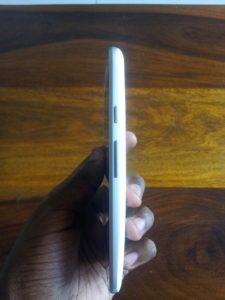

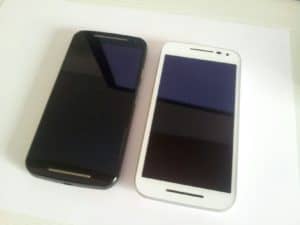
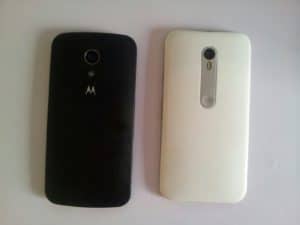
- Display – While the design saw an overhaul in the Moto G 3rd gen. , the display however, has been retained. Simply put, the Moto G 3rd Gen features the same 5 inch 720p HD display that comes in the Moto G 2nd gen. Whats more, the two displays share the same pixel density of 294 ppi. For those who are new to this, 294 ppi is just 6 points shy of being called retina grade. What I mean by retina grade is that the human eye saturates at 300 ppi, and anything above that cannot be directly perceived by us. The only way to do so, is to zoom in on those images and texts.In case of this display however, you can perceive it with your eyes, and since it is so close to retina density, you can expect crisp text and images, as well as some real punchy colours. Video playback is top notch as well, but since the display is limited to 720p, you really can’t explore the beauty of 1080p videos on this device to its entirety.As far as the protection of the display is concerned, Motorola has provided Corning Gorilla glass 3 protection, just like that on the Moto G 2nd Gen. Gorilla Glass has been known to take a few hits here and there while completely protecting the device from those nagging scratches, but when it comes to really protecting your device display, you should go in for a good quality screen protector as well.All in all, the display is pretty standard as far as mid range devices are concerned today, so there is nothing really lacking or added here. Just sweet and simple.


- Performance – The performance package has got a bump up on paper, but when it comes to real world numbers and performance, its still not very different from the Moto G 2nd Gen. Anyway, lets get into the performance.The folks at Motorola have fit the Moto G 3rd Gen device, with the Qualcomm MSM 8916 Snapdragon 410 chipset, which is arguably the best chipset there is , as far as the mid rangers are concerned. The 410 chipset features a true Quad Core 1.4 GHz Cortex A-53 CPU, and the Adreno 306 GPU. While the Quad core CPU is indeed a snappy performer, its not really stellar. The same can be said about the GPU as well. While the Adreno 306 is a definite upgrade from the Adreno 305 that graced the Moto G 2nd Gen, its still not something you can call a gaming ready GPU. Sure, you could get the device to play all the basic games, and a few demanding ones as well, but when you really want the device to go that extra mile in terms of graphics, the device starts to give in to the pressure.While this might not exactly sound sweet to the ears, what the performance package has going for it is the 64 bit architecture of the chipset. Simply put, a 64 bit processor will perform tasks much faster, act much more stable and allow for better multi-tasking than its 32 bit sibling.Overall, the performance package is apt for the price point, and the 64 bit architecture is definitely a plus point. That said, I must point out again, that if you are someone who wants a work horse that can take anything you throw at it, then you are better off buying one of those flashy flagships. On the other hand, if you are looking for a mid range device that looks good, and can also give you a decent all round performance, then the Moto G 3rd generation is a good option.
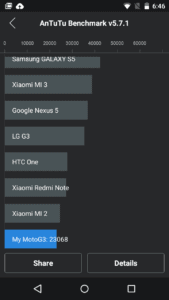
- Memory and Platform – One area where Motorola have really improved is the memory. While the Memory expansion still sticks at a maximum of 32 GB, you can now choose between two variants – one with 8 GB internal memory, and another with 16 GB of internal memory. This is definitely a move to rectify the error they made with their Moto G 2nd Gen device, where the only true complain that the people had was the fact that it didn’t have 16 GB internal memory like most other devices in its segment, along with 2 GB of RAM.Speaking of RAM, Motorola has fixed that part of the complain as well, with the 16 GB variant being coupled with 2GB of RAM, while the 8GB variant will come with just a gig of RAM only. Personally, I would have loved for Motorola to upgrade the overall RAM to 2 GB, but I guess they can do that in the 4th generation. For now, the fact that they are working towards fine tuning their devices with every new iteration is enough to keep the fans and users happy. Another thing that I must add here is that while other companies keep a minimum of 4-5 k INR gap between their variants, the difference between the 8GB and 16GB variants is just 1k INR, thus allowing users to pick their poison without worrying about that extra moolah. If I was to suggest something, I would say, go for the 16 GB variant, because not only do you get more memory, you also get more RAM, which, coupled with the 64 bit processor, is a match made in heaven. That said, if you are on a strict budget, and can’t really put in that extra 1k INR, then the 8GB variant is good too.Next up, the platform. A lot of uproar is going on about devices getting the latest Android Upgrade. While Google devices and few of the latest flagships have got the Android Lollipop 5.0 upgrade already, many of the newer brands are still struggling to get their devices upgraded, and trust me, there is nothing more frustrating than seeing others use the latest of Android , while you are stuck in the past versions, knwing full well that your device is slated to receive the upgrade as well. Now, while I mentioned Google devices and flagships, have got Android Lollipop already, I forgot to mention Motorola as well. If you don’t know or probably don;t remember, Motorola was a part of Google when they launched the Moto G, but even today, after getting sold to the Lenovo group, Motorola has stuck to their stock Android Roots , which is why, just like Google’s Nexus lineup, they too are among the first ot roll out OS upgrades. When I purchased the Moto G 2nd gen a few months back, I got the Android Lollipop OS as an OTA upgrade , the moment I boot up the device. The Moto G 3rd Gen, however, features Android Lollipop 5.1.1 ( the latest version ), out-of-box. So, all you need to do is boot your device, and enjoy the latest that Android has to offer.Overall, Motorola has nailed the memory section, by rectifying what the fans found lacking in the previous generations. The OS is also at its latest version, thus making this device a must buy.
- Camera – Coming to the camera. When I first heard that Motorola was going to release the Moto G 3rd Gen device, I had secretly hoped for an upgraded camera package, and for once, my wish was answered. What we have is a 13 MP rear camera sensor and a 5 MP front snapper to give it company. Now on paper, Motorola claims that this is the same camera setup that is found in the Moto X2, and they are not entirely wrong. The picture quality is surprisingly good, thus giving Motorola’s claim the required weight. To be honest, when you are clicking pictures on a mid ranger, you really can’t expect photos with the same quality as the ones from a high end flagship, but in case of the Moto G 3rd Gen, the camera does well both in normal, and low light conditions. The selfies are better as well. You really can’t go wrong with a 5 MP selfie snapper can you ?Video recording has been taken a step further as well, with the device being equipped to record Full HD 1080p videos at 30 fps. Another change in the camera section is the flash. While the Moto G 2nd Gen featured a single LED flash, the Moto G 3rd Gen comes with Dual LED ( Dual tone flash ), which does a much better job in low light conditions than the single flash.Overall, if you are looking for a mid range device that gives you a camera performance that exceeds expectations, then the Moto G 3rd Gen is your best bet.

